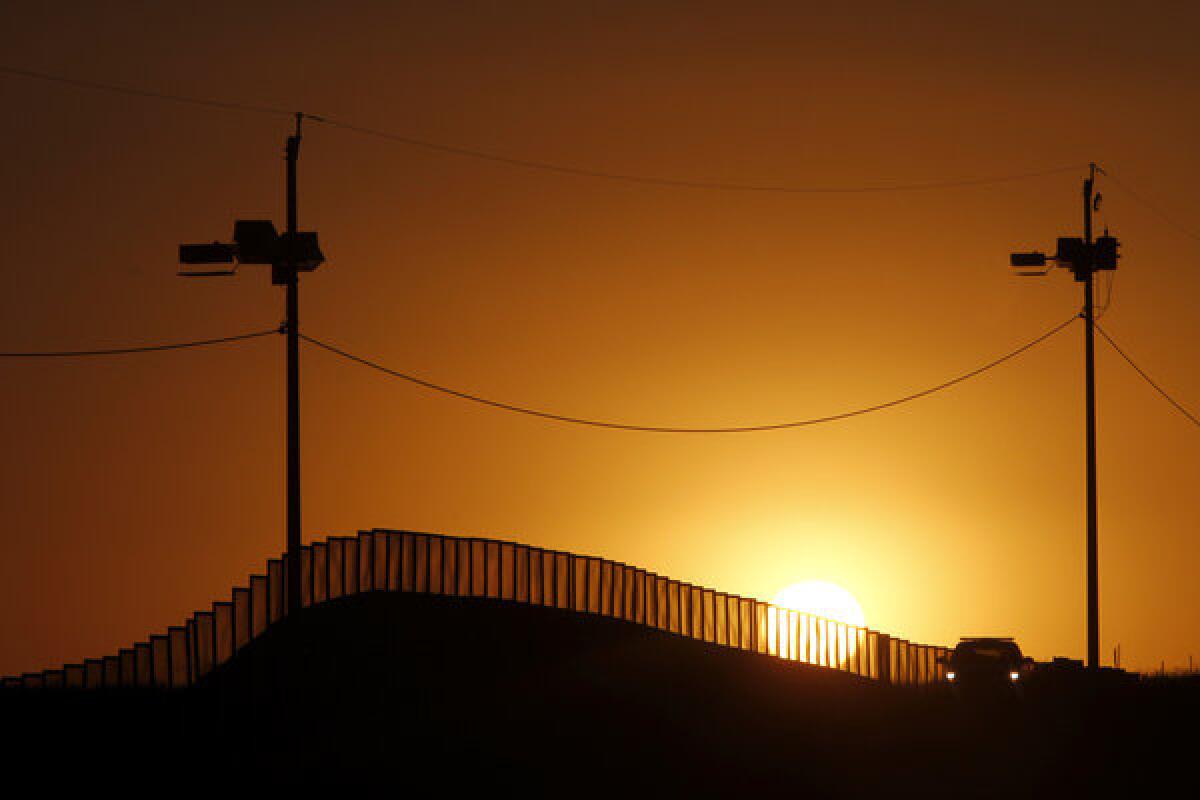In Arizona, border crossings down, but migrant deaths on rise

A Border Patrol agent keeps watch at the border fence in Naco, Ariz. Most of the recovered remains in southern Arizona in 2014 were skeletal, most were men, and most were from Mexico, the Pima County medical examiner’s annual report said.
- Share via
TUCSON — The numbers of people crossing the U.S.-Mexico border illegally into this country are at historical lows, but a report released Wednesday shows that the death rates among these migrants are at an all-time high in the southern Arizona desert.
The deaths have likely increased because those who still choose to cross the border illegally are traveling for longer periods of time — mostly on foot — through more remote areas to avoid detection by border enforcement officials, suggest data collected by the Pima County Office of the Medical Examiner.
The country is dealing with a relatively new mass death phenomenon, said Raquel Rubio-Goldsmith, an adjunct professor at the University of Arizona and co-author of the report.
“In a sense, we are dealing with a disaster,” she added.
One of the most striking findings is that Central Americans are increasingly making up a larger portion of the deaths in the Tucson area, reflecting an overall trend of greater apprehensions of this population by U.S. Border Patrol officials.
Before the ramped-up border enforcement, the medical examiner’s office reported about 12 border deaths a year. After federal officials fortified the international border along California in the 1990s, it created a funnel effect, sending many migrants east into Arizona. The first spike was seen in 2000 with 71 deaths. That number doubled two years later and hit a high in 2010 with 225 recorded deaths.
The report, based on data from 1990 to present, is a collaboration between the University of Arizona’s Binational Migration Institute and the Pima County Office of the Medical Examiner.
In that time, there were 2,238 deaths, about half of them caused by exposure, the study shows. As of today, 34% of the dead remain unidentified. Of those identified, 86% came from Mexico.
The study debuted at the same time Congress is considering an immigration overhaul that would provide a pathway to legalizing an estimated 11 million people on condition of further fortifying the southern border.
Legislators in the nation’s Capitol aren’t talking about the increased deaths, said Daniel Martinez, a Washington, D.C.-based sociology professor and co-author of the study called “A Continued Humanitarian Crisis at the Border.
“Migrant deaths really aren’t on people’s radars,” Martinez said. “What is on people’s radars is more border enforcement and more border security, and I can tell you that It will just lead to more deaths along the border.”
The authors agree that U.S. Border Patrol having more boots on the ground in more remote areas could account for the increase in the number of bodies discovered in the desert. However, the fact that the number of deaths has been elevated for more than a decade seems to indicate that more clandestine borders crossers are still dying and not just being found.
It used to be that only 7% of the dead found in the desert were, as government jargon puts it, “other than Mexican.” Now, that number is up to 17%, the report shows.
Most of these people came from Guatemala, El Salvador and Honduras, researchers said. These figures jibe with U.S. Customs and Border Protection statistics that show an increase in apprehensions of Central Americans during the same time.
ALSO:
Thousands gather to honor four fallen Houston firefighters
Searchers dig frantically amid Philadelphia building collapse
Jill Kelley sues FBI, Pentagon over David Petraeus sex scandal
Twitter: @thecindycarcamo
More to Read
Sign up for Essential California
The most important California stories and recommendations in your inbox every morning.
You may occasionally receive promotional content from the Los Angeles Times.














